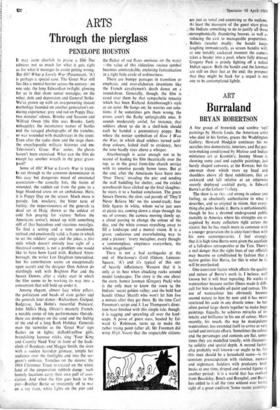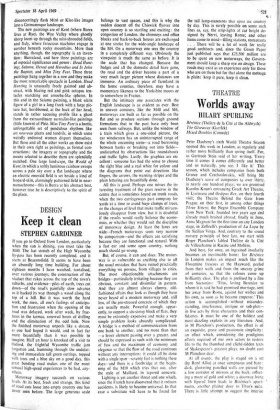Burraland
ART BRYAN ROBERTSON
A fine group of brownish and sombre `veil' paintings by Morris Louis, the American artist who died in his forties, graces the Waddington Gallery; Howard Hodgkin continues his re- searches into domesticity, interiors, and flat pat- tern-making conditioned by Matisse and Indian miniature art at Kasmin's; Jeremy Moon is showing some cool and capable paintings, just barely shaped canvases, at the Rowan; but the one-man show which rears up head and shoulders above all these exhibitions, like an awkward and tall relative at an otherwise suavely deployed cocktail party, is Edward Burra's at the Lefevre flallery.
The show is so rich and strong in colour and feeling, so absolutely authoritative in what it describes, and so original in vision, that every- thing else pales beside it. Burra is unfashionable, though he has a devoted underground public (notably in America where his strengths are re- cognised by many collectors right across the states); but he has much more in common with a younger generation (he is sixty-four) than with his own contemporaries. I feel strongly that it is high time Burra were given the accolade of a full-dress retrospective at the Tate. There's a real danger that the sight lines of our officials may become so conditioned by fashion that a native genius like Burra, for this is what he is, will be overlooked.
One consistent factor which affects the quality and nature of Burra's work is, I believe, well known but it will bear repeating. He works in watercolour because earlier illness made it diffi- cult for him to handle oil paint and canvas. The use of watercolour has obviously become second nature to him by now and it has never restricted his scale in any drastic sense: he has often pasted large sheets, together to make huge paintings. Equally, he achieves miracles of in- tensity and brilliance in his use of colour. More recently, his touch, the way he manipulates 'watercolour, has extended itself to arrive at very varied and intricate effects. Sometimes the colour and the personages and contexts are flat, some- times they are modelled tonally, with illusionis- tic solidity and spatial depth. A second factor. also probably well known—or ought to be, for -.-this man should be a household name—is the constant preoccupation with violence, menace and nightmare. Soldiers with predatory bird- beaks at one time, draped and cowled figures at another period: it is a world that has evolved from Beardsley, Bosch and Breughel, and Burra has added to it all the time without ever losing sight of a great tradition.'Some recent paintings
disconcertingly flash Mira or Klee-like images into a Cotmanesque landscape, The new paintings are of Kent (where Burra lives at Rye), the Wye Valley where ghostly sheep loom up through the mist-shrouded fields, and Italy, where ferocious machines engage in combat beneath rocky mountains. More than anything, though, the topography is an inven- tion : Burraland, and here three paintings are of especial significance and power: Head Hunt- ing; Salome, Herod and Herodius and St John the Baptist; and Miss Tiny Feet. These three paintings hang together in a row and they make the most remarkable spectacle in London. Head Hunting is unusually freely painted and ab- stract, with blazing red and pink octopus ten- tacles searching out amoeba-like spheres. In this and in the Salome painting, a blank white figure of a girl in a long frock with a large pic- ture hat, beribboned, at the back of her head, stands in rather accusing profile like a ghost from the extraordinary surrealist-like paintings (little known) of Phiz. Miss Tiny Feet is a hectic, unforgettable set of pendulous rhythms like art nouveau plants and tendrils, in which some weirdly endowed women disport themselves. But these and all the other works on show exist in their own right as paintings, as formal con- structions: the imagery or topography and the means selected to describe them are splendidly matched. One large landscape, the Weald of Kent, in which a softly luminous rainbow sweeps across a pale sky over a flat landscape where an electric emerald field is set beside a kind of leopard-skin, alarmingly patterned field in near- monochrome—this is Burra at his abstract best, however true he is descriptively to the spirit of the place.











































 Previous page
Previous page